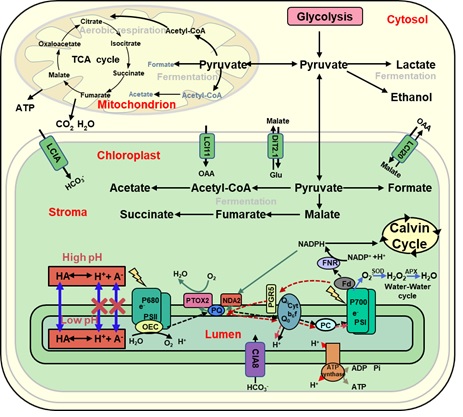In the model organism Chlamydomonas reinhardtii, photosynthesis and aerobic respiration occur in chloroplasts and mitochondria, respectively, while anaerobic fermentation can occur independently in cytoplasm, mitochondria, and chloroplasts. How these three basic energy metabolic processes can occur harmoniously within one single cell remain largely unexplored.
A research team led by Prof. TIAN Lijin from the Institute of Botany of Chinese Academy of Sciences found that anaerobic fermentation metabolites suppressing both photosynthesis and aerobic respiration. The study was published in Nature Communications.
Previous studies have shown that photosynthetic organisms gradually accumulate protons under dark treatment, leading to thylakoid lumen acidification and consequently inhibiting photosynthesis, which was tentatively assigned to either chlororespiration or ATP hydrolysis. However, the researchers ruled out these explanations respectively by using mutants that lack the relevant gene.
Considering that long-term dark adaptation of concentrated cell may undergo anoxia and thus triggers acid-type of fermentation, the researchers thus speculated that the weak acids produced during the fermentation process might have inhibited photosynthesis. To verify this idea, they prove that the degree of lumen acidification was positively correlated with the total accumulation of weak acids produced by the fermentation, whereas no acidification was detected for the green alga NIES-2499, which does not produce weak acids during fermentation metabolism. This demonstrated that fermentation is responsible for lumen acidification in darkness, and the researchers also verified that this mechanism of feedback regulation of metabolites exists in many different species of photosynthetic organisms.
Finally, given the fact that thylakoid membrane is semi-permeability to weak acid molecules, the researchers proposed the "ion trap" model: weak acids in their neutral form, no matter whether exogenously added or fermentation produced, could pass through the lipid bilayer, and ultimately enter the thylakoid, whereas the ionized ions could not escape. In this case, the pH buffering capacity in the thylakoid lumen is much lower than in stroma, therefore, the protons continue to accumulate until the thylakoid lumen gets acidified.
“This study elucidated a new mechanism by which fermentation affects photosynthesis and respiration in photosynthetic organisms, which is important for exploring the chemical coupling between photosynthesis, aerobic respiration, and anaerobic respiration. It helps understand the basic physiological processes of photosynthetic organisms and possibly be explored to optimize the growth and carbon assimilation of plants,” said Prof. Tian, the corresponding author of the study.

The scheme of metabolic pathways for Chlamydomonas (IBCAS)
Aritcle Link: https://doi.org/10.1038/s41467-023-39898-0
Contact:
Prof. TIAN Lijin, ltian@ibcas.ac.cn;
the Institute of Botany, Chinese Academy of Sciences
In the model organism Chlamydomonas reinhardtii, photosynthesis and aerobic respiration occur in chloroplasts and mitochondria, respectively, while anaerobic fermentation can occur independently in cytoplasm, mitochondria, and chloroplasts. How these three basic energy metabolic processes can occur harmoniously within one single cell remain largely unexplored.
A research team led by Prof. TIAN Lijin from the Institute of Botany of Chinese Academy of Sciences found that anaerobic fermentation metabolites suppressing both photosynthesis and aerobic respiration. The study was published in Nature Communications.
Previous studies have shown that photosynthetic organisms gradually accumulate protons under dark treatment, leading to thylakoid lumen acidification and consequently inhibiting photosynthesis, which was tentatively assigned to either chlororespiration or ATP hydrolysis. However, the researchers ruled out these explanations respectively by using mutants that lack the relevant gene.
Considering that long-term dark adaptation of concentrated cell may undergo anoxia and thus triggers acid-type of fermentation, the researchers thus speculated that the weak acids produced during the fermentation process might have inhibited photosynthesis. To verify this idea, they prove that the degree of lumen acidification was positively correlated with the total accumulation of weak acids produced by the fermentation, whereas no acidification was detected for the green alga NIES-2499, which does not produce weak acids during fermentation metabolism. This demonstrated that fermentation is responsible for lumen acidification in darkness, and the researchers also verified that this mechanism of feedback regulation of metabolites exists in many different species of photosynthetic organisms.
Finally, given the fact that thylakoid membrane is semi-permeability to weak acid molecules, the researchers proposed the "ion trap" model: weak acids in their neutral form, no matter whether exogenously added or fermentation produced, could pass through the lipid bilayer, and ultimately enter the thylakoid, whereas the ionized ions could not escape. In this case, the pH buffering capacity in the thylakoid lumen is much lower than in stroma, therefore, the protons continue to accumulate until the thylakoid lumen gets acidified.
“This study elucidated a new mechanism by which fermentation affects photosynthesis and respiration in photosynthetic organisms, which is important for exploring the chemical coupling between photosynthesis, aerobic respiration, and anaerobic respiration. It helps understand the basic physiological processes of photosynthetic organisms and possibly be explored to optimize the growth and carbon assimilation of plants,” said Prof. Tian, the corresponding author of the study.

The scheme of metabolic pathways for Chlamydomonas (IBCAS)
Aritcle Link: https://doi.org/10.1038/s41467-023-39898-0
Contact:
Prof. TIAN Lijin, ltian@ibcas.ac.cn;
the Institute of Botany, Chinese Academy of Sciences
